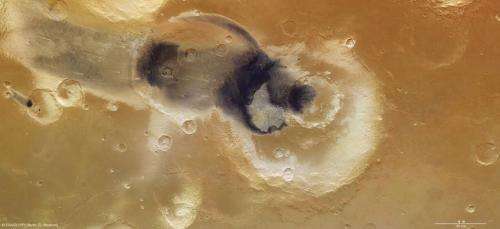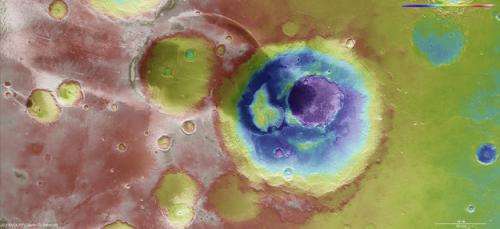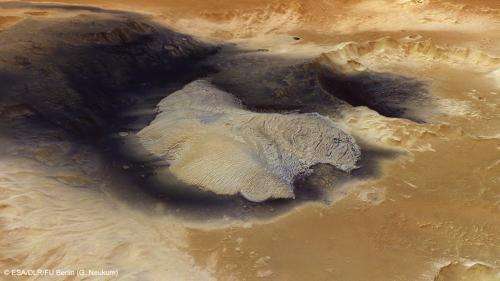A striking scene in and around Becquerel crater – the largest crater in this view – reveals both the power of wind and water in the turbulent history of Mars. A mound of light-coloured sulphate deposits formed from evaporating water sits inside the crater amid a sea of dark wind-blown deposits. The darker material has blown towards the south-southwest (top left) of the image in a wide swath and across tiny craters there – their raised rims protect the material immediately downwind from being swept away. Credit: ESA/DLR/FU Berlin (G. Neukum)
(Phys.org) —Exceptional structures deposited and shaped by water and winds adorn these interlocking craters and sculpt radiating patterns in the sands of Mars.
This mosaic, which focuses on Becquerel crater in Arabia Terra, is composed of four images taken by the high-resolution stereo camera on ESA's Mars Express. Arabia Terra is in the transition zone between the southern highlands and the northern lowlands of Mars.
Becquerel crater is named for the 19th-century French physicist Antoine Henri Becquerel (1852–1908), winner of the Nobel Prize in physics in 1903 along with Marie and Pierre Curie for the discovery of radioactivity.
It is the largest crater in this scene, with a diameter of 167 km, and drops to a depth of about 3.5 km below the surrounding terrain. A second large crater lies within Becquerel, punching even deeper into the surface, as seen in the Mars Express topography and 3D images.
The perspective view below reveals an intriguing, large mound within Becquerel's crater walls, reminiscent of Mount Sharp in Gale crater, currently being explored by NASA's Curiosity rover.
The mound rises about 1 km above the crater floor and comprises hundreds of layers of light-toned sediments, each just a few metres thick, made of sulphate-bearing rocks. On Earth, sulphates are most often formed via the evaporation of water, so the presence of these minerals in Becquerel crater suggests that water may once have pooled here in a vast crater lake, before evaporating away.
Location of Becquerel crater within Arabia Terra, at about 22°N/352°E. The main image is a mosaic of four images taken by the High Resolution Stereo Camera on ESA’s Mars Express on 22 July 2006 (orbit 3253), 26 February 2008 (orbit 5332), 2 March 2008 (orbit 5332) and 7 March 2008 (orbit 5368). The orbit tracks and the area highlighted in the main image are indicated by the white rectangles. Credit: NASA MGS MOLA Science Team
It is likely that the entire crater floor was once covered with such sediments, but over billions of years much of it has been eroded away by wind, leaving just a polished, rounded mound behind.
Similar light-toned sulphate-bearing deposits are seen all over Arabia Terra, including in the crater walls in this scene, pointing to a large-scale process that affected the entire region.
One popular theory is that large changes in the tilt of the rotational axis of Mars leads to significant changes in its climate, reflected in the thickness and repeating patterns found in the layers of sediment. A change in the environmental conditions would affect the way in which the sediments were initially deposited, as well as their subsequent resistance to erosion.
The deposits were laid down 3.8–3.5 billion years ago, at a time when Mars was evolving from a warm, wet world into the cold and dry planet we see today.
Although water may no longer flow on the Red Planet, wind still plays a key role in shaping the environment. Dark dunes and wind-blown sediments streak through this scene, in vivid contrast to the bright mound.
Rather than having originated locally, the dark material inside Becquerel crater likely blew in from elsewhere – perhaps even from volcanic eruptions.
Becquerel crater topography.
A dark streak seems to drag the material out from the craters in a wide swath towards the upper left of the main colour image (bottom right of the perspective view above). A number of tiny craters with tail-like structures lie along this track: their raised rims influence the flow of wind over them such that the material immediately downwind of the crater remains undisturbed in comparison to the surrounding, exposed plains.
Another streak of dust follows a radial path out of Becquerel crater; it likely traces out a gentle topographic depression, beyond the eroded rim of the neighbouring old crater.
Meanwhile, dark sediments inside the small crater towards the far left of the main image appear to have been blown out in a similar direction by the powerful prevailing wind.
This detailed view of the approximately 1 km high mound inside Becquerel crater reveals its intricate layering. The layers are just a few metres thick each and are composed of sulphate-bearing minerals left behind after water has evaporated. Repeating patterns in the layers could reflect climatic changes that occurred as Mars evolved from a warm, wet world into a cold, dry planet some 3.5–3.8 billion years ago. The dark sediments were likely blown in from outside the crater, but local erosion of the mound may also have contributed to the supply of sediment. Credit: ESA
These blowing sands continue to change the martian landscape even today, exposing ancient rock formations in some locations, while eradicating or covering younger features in others. Detailed studies of these wind-blown patterns can often yield interesting insights into the history of the Red Planet.
Provided by European Space Agency



























